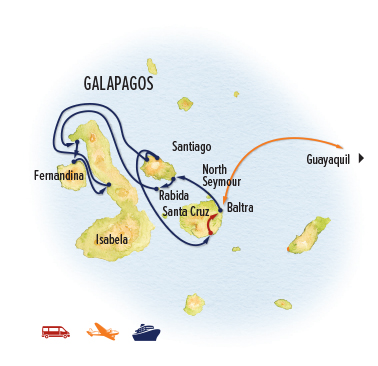Itinerary
Guests have the choice to arrive into Quito, Ecuador's capital with its World Heritage-status colonial Old Town, or Guayaquil, a vibrant coastal city with a lively waterfront malecon along the Rio Guayas. Guests in Quito will have the choice of several hotels, while those arriving into Guayaquil will spend the night at the Hotel del Parque, an elegantly restored 19th-century boutique inn surrounded by tropical gardens, before flying to the islands tomorrow. In both cities, a selection of local tours is available.
Fly this morning to the Galapagos island of Baltra, and transfer to the pier on arrival to board the National Geographic Islander II. Once you're settled in, the ship sets sail straightaway for a week of adventure. Crossings between islands generally take place at night to maximize time for exploration during the day. Look forward to waking each morning to fresh vistas and daily discoveries.
Each day a new island awaits, and with flexibility a hallmark of Lindblad's expedition style, opportunities for discovery abound. Below is a sampler of the islands we may visit. In each location, enjoy personal encounters with the fascinating animals of the Galapagos, which are perfectly comfortable with humans and won’t run away in fear. Choose among multiple modes of exploration each day: Take a guided hike with the ship's naturalists. Swim with tropical fish, sea turtles and penguins on daily snorkeling excursions—sometimes twice a day—that showcase the rich marine life of the Galapagos. Paddle a single or tandem kayak for water-level investigation of the scenic coastline. Step onto a stand-up paddleboard for meditative exploration of quiet bays. Hop onto a Zodiac to cruise along rocky shores dotted with blue-footed boobies, marine iguanas and bright orange Sally lightfoot crabs—an ideal excursion for photography, illuminated with a naturalist’s narration.
Your itinerary will include a selection of these islands:
North Seymour
Encounter plentiful sea lions, nesting frigatebirds, plus land and marine iguanas, and enjoy a striking views on a coastal walk.
Santa Cruz
Call at Puerto Ayora, the largest town and headquarters of both Galapagos National Park and Charles Darwin Research Station, which operate in partnership. At Darwin Station, learn about the efforts of scientists, guides, rangers and park managers to preserve the unique features of the UNESCO World Heritage Site that is the Galapagos Islands. At the tortoise-rearing facility, see tiny babies bred to help increase the depleted tortoise population, a central part of the station's conservation mission. To date, more than 5,000 tortoises have been returned to the wild in the Galapagos through the program. Santa Cruz is also home to wild Galapagos tortoises, the islands' namesake, which dwell in the misty Scalesia forests of the highlands.
Isabela
Isabela, largest of the Galapagos islands, was created when six volcanoes flowed together. Today, its shape resembles a seahorse. In addition to kayaking and deep-water snorkeling, a small black sand beach offers excellent swimming. Varied choices for walks and hikes ashore reveal Isabela's intriguing features, including an iguana colony and a chance to cross the equator at Ecuador Volcano, the northernmost of Isabela’s six great shield volcanoes. Keep an eye out for whales and dolphins as we ply these waters rich in marine life, which were once the haunt of whalers and pirates.
Fernandina
The youngest and most active volcano in the Galapagos, Fernandina is one of the most pristine tropical islands left on Earth. Hike over relatively recent lava flows among hundreds of placid marine iguanas (the largest in the Galapagos), flightless cormorants, and bright orange Sally Lightfoot crabs that speckle the black lava rocks. Galapagos hawks soar overhead while sea lions loll on the sun-baked lava.
San Cristobal
Search for red-footed boobies and the endemic mockingbird and lava lizard—found only on this easternmost island. Explore Baquerizo Moreno, where sea lions thrive in the middle of town.
Española
Española is one of the most prolific wildlife sites in the Galapagos. Hike to Punta Suarez, the seasonal home of the world's only population of waved albatross. The island's endemic red-and-green marine iguanas are also found only here. Española is also home to Darwin’s finches, Galapagos mockingbirds, Galapagos hawks, Galapagos doves, Nazca boobies, and the famous blue-footed boobies. A huge colony of sea lions lazes on the beach at Gardner Bay, covering the long stretch of fine, powdery white sand. Snorkeling in the bay is generally excellent, too.
Floreana
One of the few Galapagos islands inhabited by humans, Floreana has a rich cultural history filled with intrigue, including tales of pirates who once hid out here. A post office established by British whalers in 1793 is still a means for travelers to leave mail in the barrel for personal delivery via visitors passing through. Snorkel among sea lions and schools of tropical fish in the clear waters off Champion Islet, where we may also find flamingos, pintail ducks and various shorebirds. Hike to a pristine white sand beach, a favorite nesting site for sea turtles.
Our ship has returned to our disembarkation port overnight, and we depart after breakfast this morning, heading to the airport for our flight back to the mainland. You may choose to overnight in Guayaquil, where a transfer is included to the Hotel del Parque, or in Quito, where a choice of hotels is available. The afternoon and evening are at your leisure. Depending on flight schedules, you may be able to take advantage of an overnight flight home.
You are free to depart at any time today. A transfer to the airport is included. Fly homeward, or stay on for an optional extension in the Ecuadorian Andes.
Learn more about the seasonal variations of Galapagos weather and wildlife viewing .


































